Model Test Analysis of Subsurface Cavity and Ground Collapse Due to Broken Pipe Leakage
Abstract
1. Introduction
2. Testing Program
2.1. Testing Apparatus
2.2. Testing Material
2.3. Testing Procedure
3. Results and Discussion
3.1. Cavity Initiation and Evolution Processes
- (1)
- During the loading process, the seepage force of the flowing water could not cause effective erosion on the experimental soil, the scouring effect on the cavity walls was reduced, and the cavity was in a stable state.
- (2)
- During the unloading process, the pressure of the flowing water on the cavity wall decreased, the experimental soil layer was lost, an increasing amount of soil around the cavity became loose, and the cavity shrunk.
- (3)
- Reloading caused the cavity to expand under sudden pressure. During the expansion and shrinkage process, the structure of the cavity wall gradually deteriorated, and the flowing water gradually eroded the soil. The scale of the cavity was in a stable development state.
- (1)
- From 480 s onward, the pressure in the 502# and 202# pressure boxes directly above the crack exhibited the same waveform; however, there was a significant drop in the pressure, indicating that the cavity wall above had been damaged.
- (2)
- Due to the direction of the water flow from left to right, the pressure in the 503# pressure box on the right side also decreased due to the pressure release from the cavity wall damage. The pressure in the 501# pressure box on the left side decreased; because the wall of the cavity above and on the right side was destroyed first, an increasing amount of soil around the cavity was lost, and the cavity gradually expanded, because of which the water flow formed a swirl on the left side and the pressure dropped after a sudden increase.
- (3)
- The 201# and 203# pressure boxes were located on the left and right sides of the vertical plane of the upper crack, where the uplift of the ground surface caused the earth pressure to rise.
- (1)
- In the pipe wall perforation group with smaller cracks, the crack diameters were 20, 30, and 40 mm, though the cavity height hovered between 65 mm and 70 mm and the cavity width increased from 174 to 215 mm. As the crack size increased, the water flow from the pipe into the soil cavity increased, thereby increasing the seepage force of the flowing water on the soil; the underground cavity increased with the crack size, the area of the soil cavity continued to expand, and the underground cavity exhibited an oval shape (Figure 8a).
- (2)
- In the experimental group of circumferential damage, the width and height of the 1/4 circumferential crack cavity was 490 mm and 40 mm respectively, while the width of the 1/2 circumferential crack cavity was only 154 mm; the height was 68 mm. The width and height of the cavity varied considerably in both the groups, and the soil cavity formed by soil erosion damage exhibited two different shapes (Figure 8b).
- (3)
- In the vertical damage experimental group, the width and height of the cavity formed in the two groups of experiments were similar. The cavities formed by 1 cm and 2 cm vertical cracks were 280 mm wide, 59 mm high and 270 mm wide and 58 mm high, respectively.
- (4)
- From a comparison of the crack types, the vertical damage took only a short time for the pressure pipelines, because water at high speeds and pressures can quickly flow out and scour the soil around the pipelines; the cavity was significantly larger in area and degree of damage than the erosion cavity formed by circular cracks on the soil around the pipe.
3.2. Degree of Ground Collapse
4. Conclusions
- (1)
- By studying three sets of experimental processes, the evolution of ground collapse under the action of pipe breakage was obtained and divided into three stages: the soil erosion stage, the stable stage of cavity development, and the ground collapse stage.
- (2)
- Among the different crack types, vertical damage had the worst damage and greatest impact on the degree of cavity development and ground collapse, with a short evolutionary process and sudden formation of ground collapse. Across the different crack sizes, there was an increase in both the underground cavity size and the degree of ground collapse with increasing crack size, leading to an increase in the seepage force of the water in the pipeline; however, this increase was significantly lessened below a certain critical size.
- (3)
- When studying the laws of cavity evolution and ground collapse development under the action of pipeline breakage, the two laws had a number of similarities, further revealing the significance of studying the evolution process of cavities for ground collapse prediction.
- (1)
- The soil model box for the experiment was designed in the form of a semi-structure. Although silicone oil was applied to the walls of the model box, there are necessarily interaction forces between the soil in the model box and the inner walls of the model box, making it difficult to achieve the actual boundary conditions of the soil.
- (2)
- In order to better realize the development process of the underground cavity and to achieve the effect of ground collapse, the loading and unloading method was applied in the experiment; however, this method does not fully conform to the normal formation pattern of underground cavities.
- (3)
- The test box design was too small, and when the water pressure in the pipe was excessive, the water flowed to the ground from the boundary between the test box and the soil.
Author Contributions
Funding
Data Availability Statement
Conflicts of Interest
References
- Wang, X.W.; Xu, Y.S. Investigation on the phenomena and influence factors of urban ground collapse in China. Nat. Hazards. 2022, 113, 1–33. [Google Scholar] [CrossRef]
- Song, G.C.; Ye, Y.C.; Liu, Q.R. Settlement causation and countermeasure analysis of urban roads in Beijing. Urban Roads Bridges Flood Control 2011, 250–252. (In Chinese) [Google Scholar] [CrossRef]
- Fu, D.; Cai, J.T.; Zhang, H. Numerical simulation of ground collapse caused by pipeline breakage in Shanghai. Geotech. Eng. Tech. 2018, 32, 189–193. (In Chinese) [Google Scholar]
- Yan, F.; Qiu, W.; Sun, K.; Jiang, S.; Huang, H.; Hong, Y.; Hou, Z. Investigation of a large ground collapse, water inrush and mud outburst, and countermeasures during subway excavation in Qingdao: A case study. Tunn. Undergr. Sp. Tech. 2021, 117, 104127. [Google Scholar] [CrossRef]
- Wang, J.A.; Shang, X.C.; Ma, H.T. Investigation of catastrophic ground collapse in Xingtai gypsum mines in China. Int. J. Rock Mech. Min. 2008, 45, 1480–1499. [Google Scholar] [CrossRef]
- Shu, B.; Ma, B. Study of ground collapse induced by large-diameter horizontal directional drilling in a sand layer using numerical modeling. Can. Geotech. J. 2015, 52, 1562–1574. [Google Scholar] [CrossRef]
- Phien-wej, N.; Giao, P.H.; Nutalaya, P. Land settlement in Bangkok, Thailand. Eng. Geol. 2006, 82, 187–201. [Google Scholar] [CrossRef]
- Nguyen, Q.T. The main causes of land settlement in Ho Chi Minh City. Procedia Eng. 2016, 142, 334–341. [Google Scholar] [CrossRef]
- Chaussard, E.; Amelung, F.; Abidin, H.; Hong, S.H. Sinking cities in Indonesia: ALOS PALSAR detects rapid settlement due to groundwater and gas extraction. Remote Sens. Environ. 2013, 128, 150–161. [Google Scholar] [CrossRef]
- Rahnema, H.; Mirasi, S. Seismic and geotechnical study of land subsidence and vulnerability of rural buildings. Int. J. Geosci. 2012, 3, 878–884. [Google Scholar] [CrossRef]
- Rahnema, H.; Mirassi, S. Study of land subsidence around the city of Shiraz. Sci. Iran. Trans. A Civ. Eng. 2016, 23, 882–895. [Google Scholar]
- Liu, C.M.; Wei, H.Y.; Zhang, H.J. Relationship between urban road collapse and underground pipeline. Urban Geotech. Invest. Surv. 2020, 183–187. (In Chinese) [Google Scholar] [CrossRef]
- Hu, Y.H.; Bai, Y.C.; Xu, H.J. Analysis of reasons for urban road collapse and prevention and control countermeasures in recent decade of China. Highways 2016, 61, 130–135. (In Chinese) [Google Scholar]
- Wang, Y.L.; Lu, Y. CFD-DEM joint calculation and simulation of disaster mechanism of pavement collapse caused by pipeline breakage in urban areas. J. Civ. Environ. Eng. 2021, 43, 60–67. (In Chinese) [Google Scholar]
- Zhou, H.T.; Liu, C.Q.; Wang, G.H.; Kang, K.; Liu, Y.H. Study on drilling ground collapse induced by groundwater flow and prevention based on a coupled CFD-DEM method. KSCE J. Civ. Eng. 2022, 26, 2112–2125. [Google Scholar] [CrossRef]
- Ben-Mansour, R.; Habib, M.A.; Khalifa, A.; Youcef-Toumi, K.; Chatzigeorgiou, D. Computational fluid dynamic simulation of small leaks in water pipelines for direct leak pressure transduction. Comput. Fluids 2012, 57, 110–123. [Google Scholar] [CrossRef]
- Peche, A.; Graf, T.; Fuchs, L.; Neuweiler, I. A coupled approach for the three-dimensional simulation of pipe breakage in variably saturated soil. J. Hydrol. 2017, 555, 569–585. [Google Scholar] [CrossRef]
- Lau, P.K.W.; Cheung, B.W.Y.; Lai, W.W.L.; Sham, J.F.C. Characterizing pipe breakage with a combination of GPR wave velocity algorithms. Tunn. Undergr. Sp. Tech. 2021, 109, 103740. [Google Scholar]
- Qi, G.; Wang, Z.; Chen, Y.; Zhu, C.; Ren, D.; Tian, T.; Yang, F. Analysis of instability mechanism and induced cause of urban pavement in Xining City, China. Adv. Mater. Sci. Eng. 2022, 2022, 3365402. [Google Scholar] [CrossRef]
- Al-Halbouni, D.; Holohan, E.P.; Taheri, A.; Schöpfer, M.P.J.; Emam, S.; Dahm, T. Geomechanical modelling of sinkcavity development using distinct elements: Model verification for a single void space and application to the Dead Sea area. Solid Earth 2018, 9, 1341–1373. [Google Scholar] [CrossRef]
- Rahnema, H.; Mirassi, S.; Dal Moro, G. Cavity effect on Rayleigh wave dispersionand P-wave refraction. Earthq. Eng. Eng. Vib. 2021, 20, 79–88. [Google Scholar] [CrossRef]
- Mirassi, S.; Rahnema, H. Deep cavity detection using propagation of seismic waves in homogenous halfspace and layered soil media. Asian J. Civ. Eng. 2020, 21, 1431–1441. [Google Scholar] [CrossRef]
- Tang, Y.; Chan, D.H.; Zhu, D.Z. A coupled discrete element model for the simulation of soil and water flow through an orifice. Int. J. Numer. Anal. Met. 2017, 41, 1477–1493. [Google Scholar] [CrossRef]
- Cui, X.L.; Tao, G.L.; Li, J. Experiment and numerical simulation on seepage failure of sand caused by breakage of underground water pipe. IOP Conf. Ser. Earth Env. Sci. 2018, 153, 032033. [Google Scholar] [CrossRef]
- Indiketiya, S.; Jegatheesan, P.; Rajeev, P. Evaluation of defective sewer pipe–induced internal erosion and associated ground deformation using laboratory model test. Can. Geotech. J. 2017, 54, 1184–1195. [Google Scholar] [CrossRef]
- Nazari SGholami, R.; Mirassi, S. Laboratory evaluation of Scour rate and energy dissipation in Gabion Stepped Weirs with considering the effect of Discharge and tail water depth. J. Appl. Sci. Agric. 2014, 9, 1424–1439. [Google Scholar]
- Ali, H.; Choi, J. Risk prediction of sinkcavity occurrence for different underground soil curves due to breakage from underground sewer and water pipelines. Sustainability 2019, 12, 310. [Google Scholar] [CrossRef]
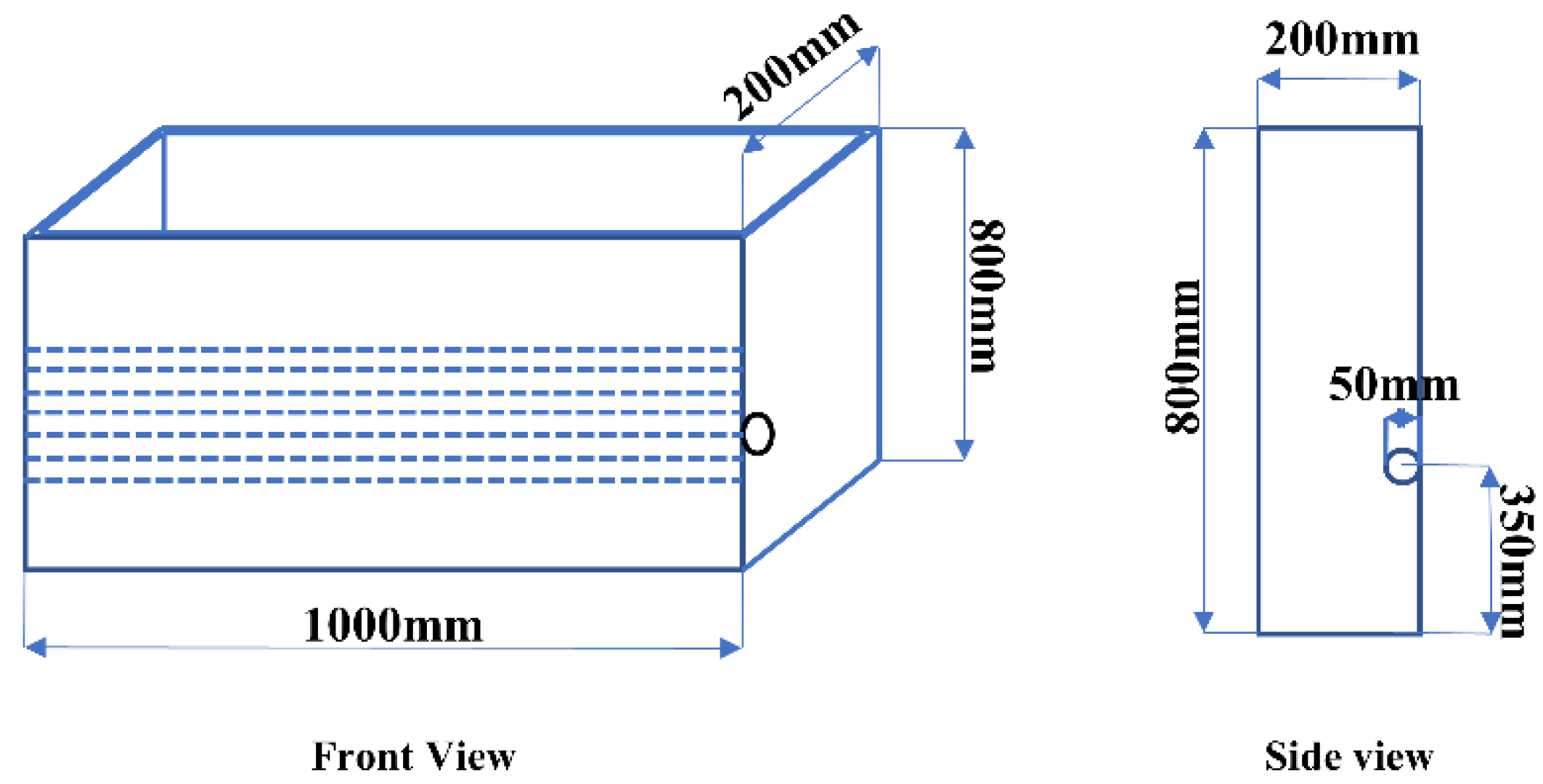
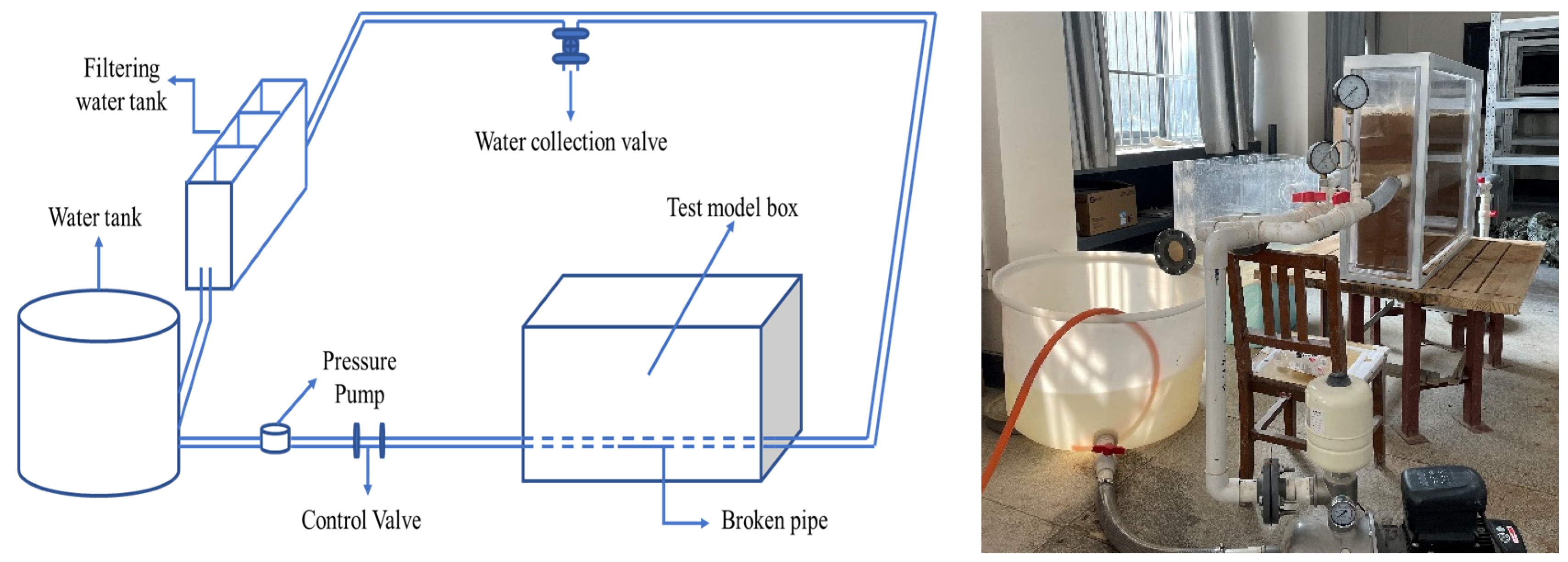

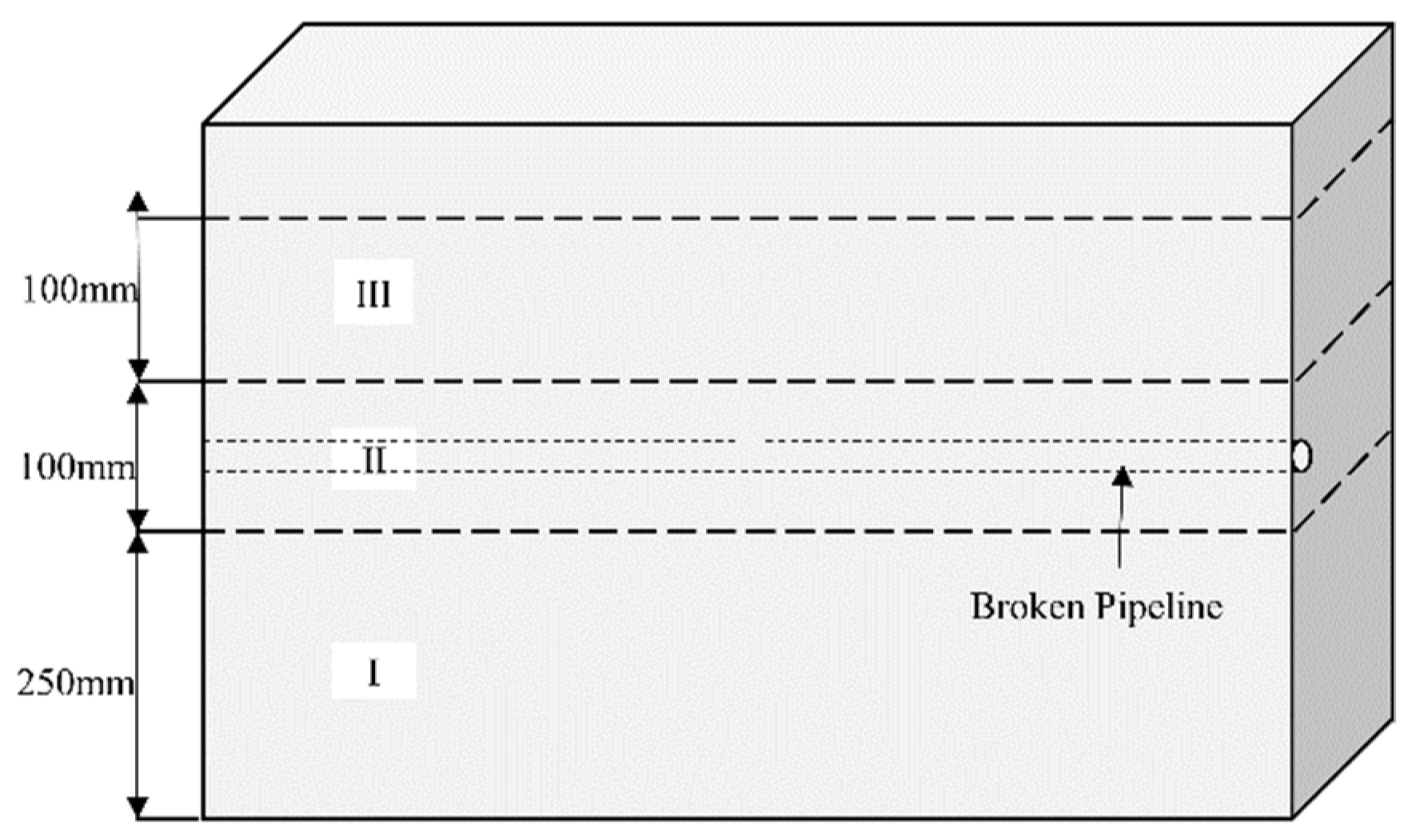
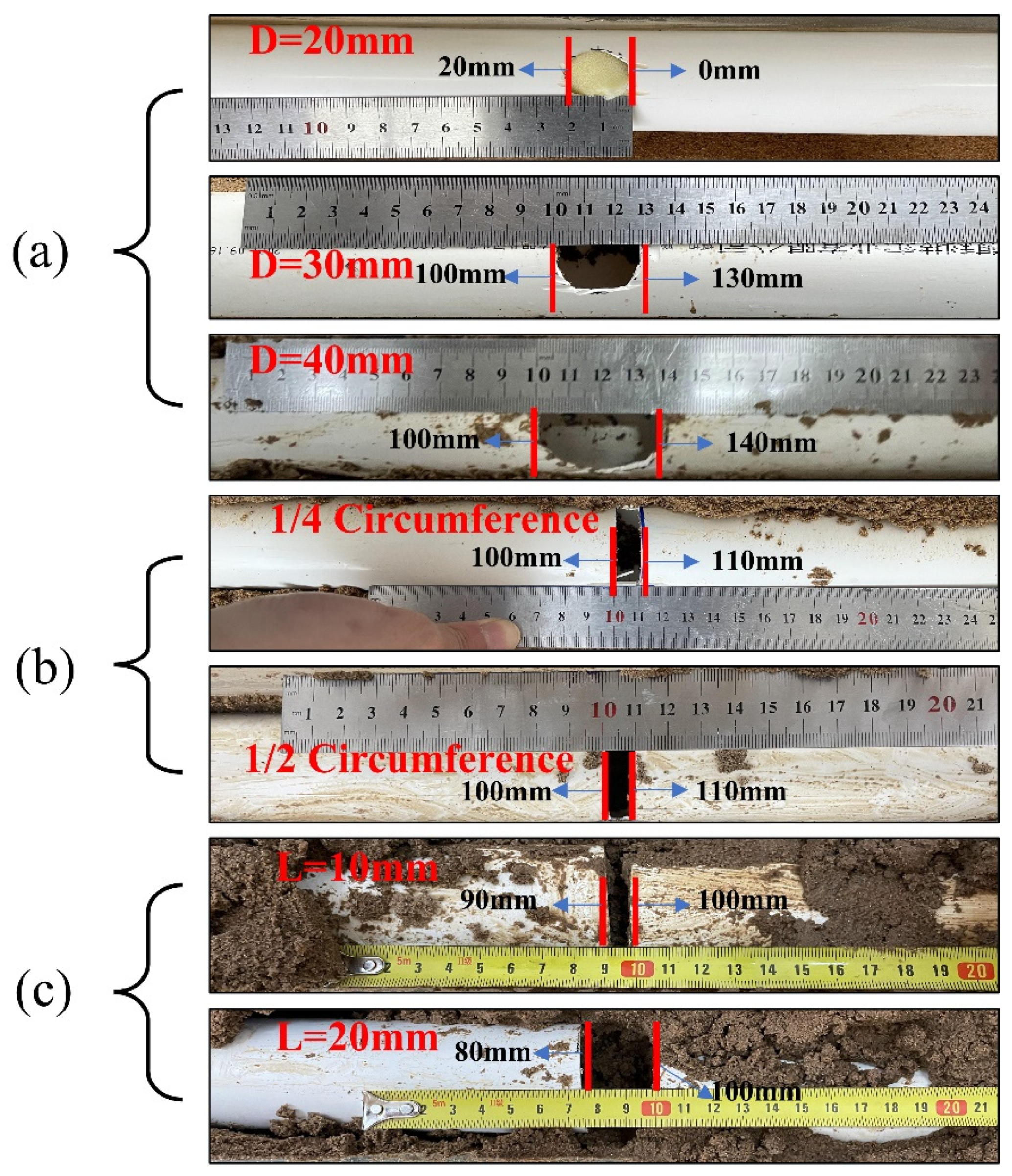
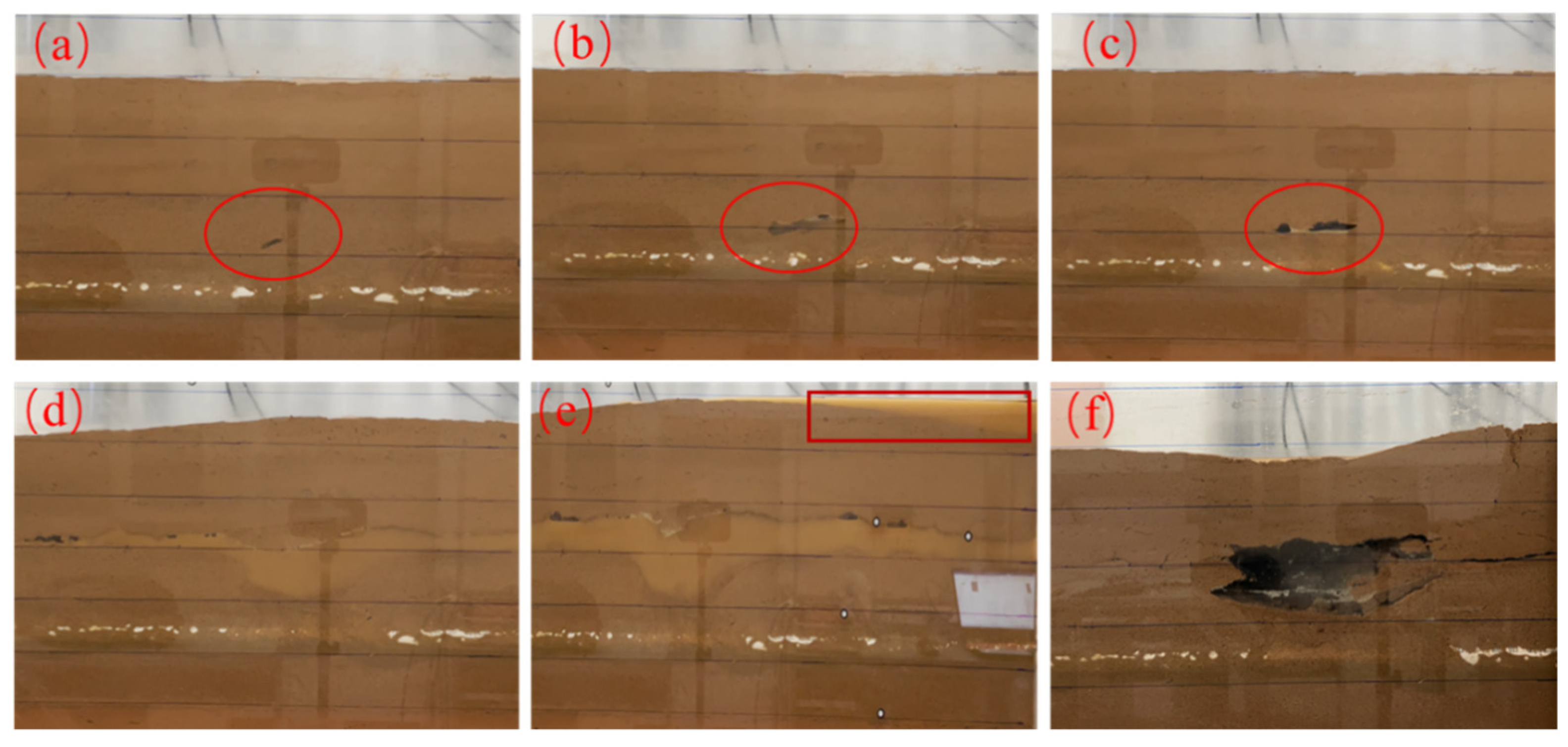
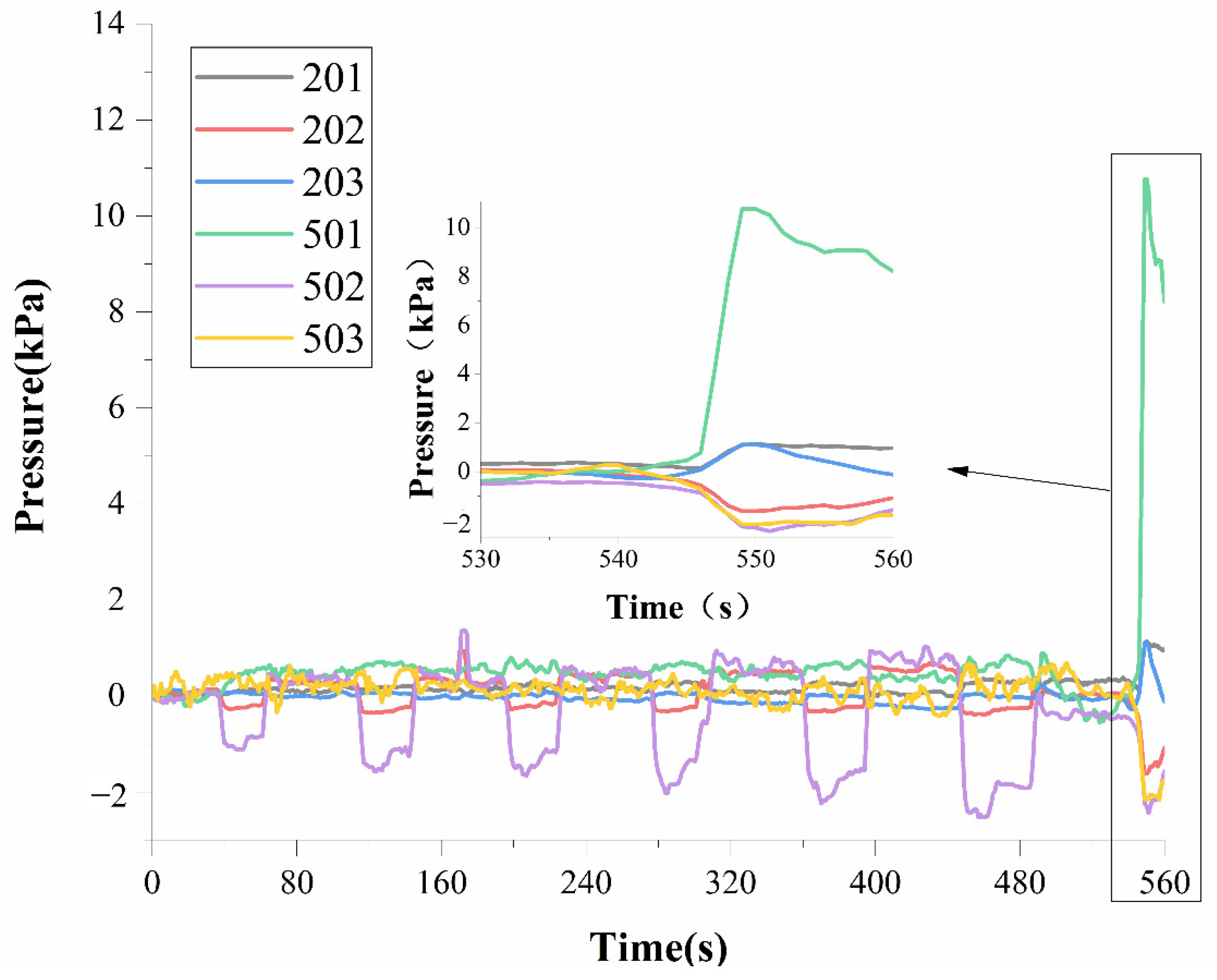
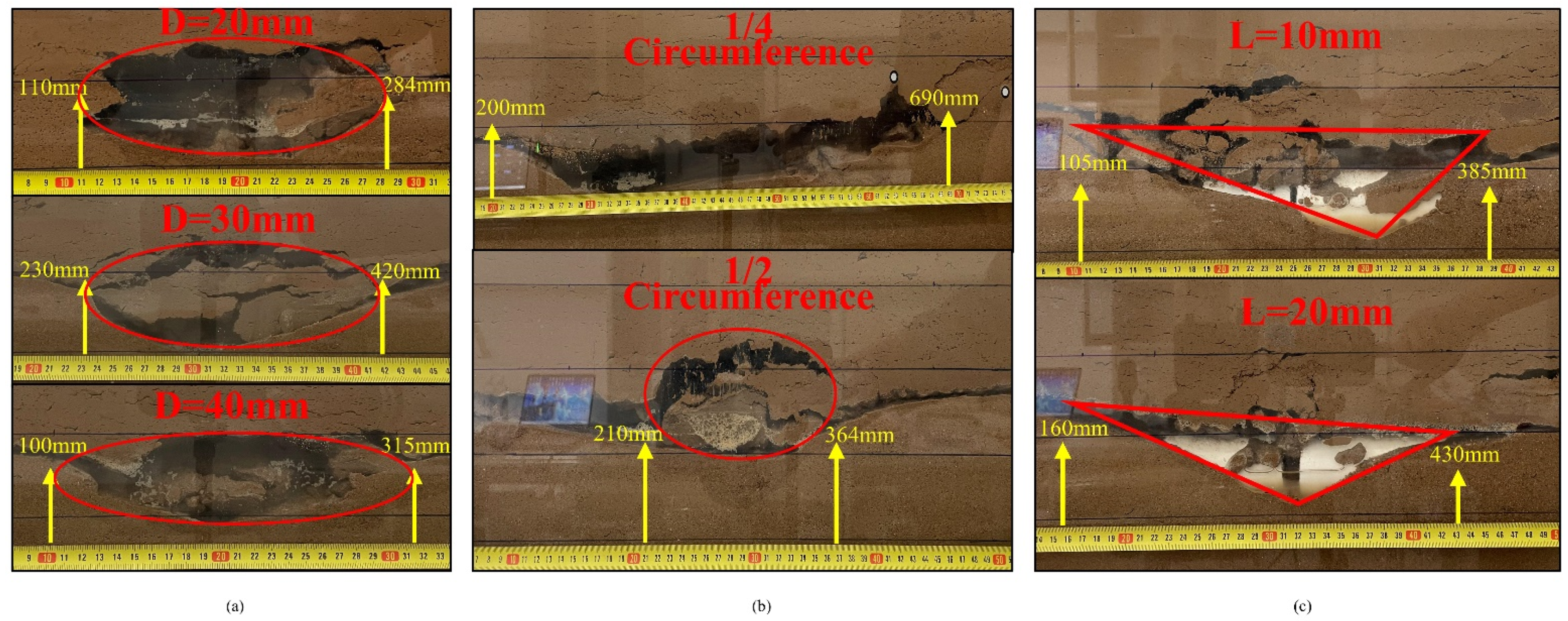
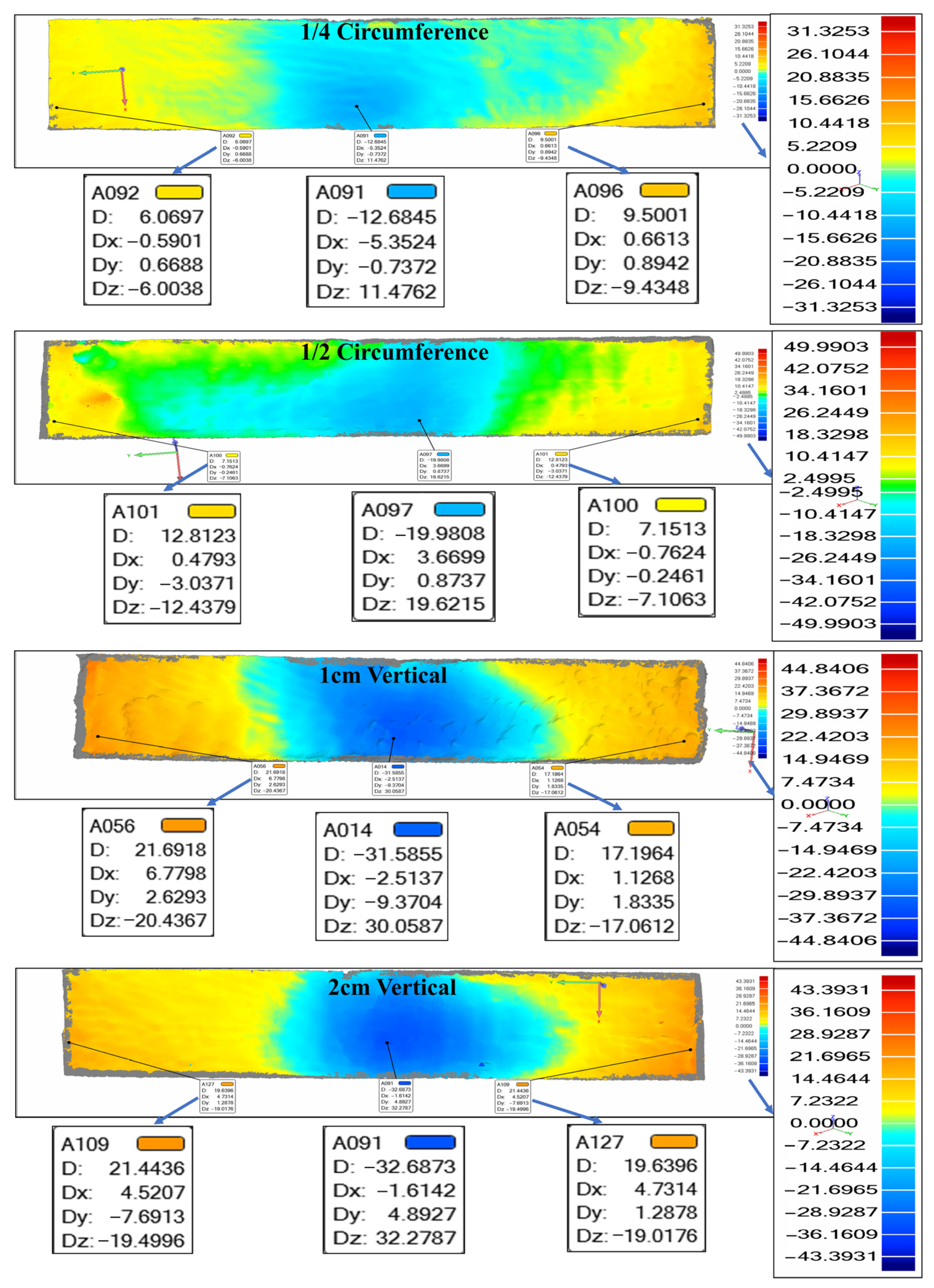
| Type of Cavity | Cavity Height (mm) | Cavity Width (mm) | |
|---|---|---|---|
| Pipe wall perforation group | 20 mm-diameter circular crack | 66 | 174 |
| 30 mm-diameter circular crack | 70 | 190 | |
| 40 mm-diameter circular crack | 65 | 215 | |
| Circumferential damage group | 1/4 circumferential crack | 40 | 490 |
| 1/2 circumferential crack | 68 | 154 | |
| Vertical damage group | 1 cm vertical crack | 59 | 280 |
| 2 cm vertical crack | 58 | 270 | |
| Type of Cavity | Settlement above Cracks (mm) | Length of the Ground Settlement Area (mm) | |
|---|---|---|---|
| Pipe wall perforation group | 20 mm-diameter circular crack | 13 | 335 |
| 30 mm-diameter circular crack | 18 | 402 | |
| 40 mm-diameter circular crack | 17 | 435 | |
| Circumferential damage group | 1/4 circumferential crack | 12.7 | 339 |
| 1/2 circumferential crack | 20 | 490 | |
| Vertical damage group | 1 cm vertical crack | 31.6 | 434 |
| 2 cm vertical crack | 32.7 | 452 | |
Publisher’s Note: MDPI stays neutral with regard to jurisdictional claims in published maps and institutional affiliations. |
© 2022 by the authors. Licensee MDPI, Basel, Switzerland. This article is an open access article distributed under the terms and conditions of the Creative Commons Attribution (CC BY) license (https://creativecommons.org/licenses/by/4.0/).
Share and Cite
Tan, F.; Tan, W.; Yan, F.; Qi, X.; Li, Q.; Hong, Z. Model Test Analysis of Subsurface Cavity and Ground Collapse Due to Broken Pipe Leakage. Appl. Sci. 2022, 12, 13017. https://doi.org/10.3390/app122413017
Tan F, Tan W, Yan F, Qi X, Li Q, Hong Z. Model Test Analysis of Subsurface Cavity and Ground Collapse Due to Broken Pipe Leakage. Applied Sciences. 2022; 12(24):13017. https://doi.org/10.3390/app122413017
Chicago/Turabian StyleTan, Fei, Wufeiyu Tan, Feifei Yan, Xin Qi, Qinghua Li, and Zhikai Hong. 2022. "Model Test Analysis of Subsurface Cavity and Ground Collapse Due to Broken Pipe Leakage" Applied Sciences 12, no. 24: 13017. https://doi.org/10.3390/app122413017
APA StyleTan, F., Tan, W., Yan, F., Qi, X., Li, Q., & Hong, Z. (2022). Model Test Analysis of Subsurface Cavity and Ground Collapse Due to Broken Pipe Leakage. Applied Sciences, 12(24), 13017. https://doi.org/10.3390/app122413017






